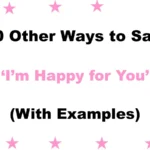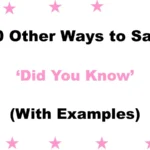Finding the right words to respond to someone’s message—especially in a professional setting—can elevate your communication. Saying “Thank you for your reply” is a respectful and polite phrase, but sometimes you want to express more warmth, appreciation, or clarity.
Whether you’re replying to a client, colleague, recruiter, or vendor, using the right alternative can make your message feel more personal, grateful, and thoughtful. Below, you’ll find 30 professional ways to say it, each crafted to suit different tones and situations—so your emails never feel dry or robotic again.
What Does “Thank You for Your Reply” Mean?
“Thank you for your reply” is a courteous acknowledgement used when someone has responded to your message, inquiry, or request. It expresses appreciation for the other person’s time, attention, and effort in getting back to you. In professional communication, it helps maintain positive relationships, sets a respectful tone, and shows that you value the interaction.
When to Use “Thank You for Your Reply”
You can use “Thank you for your reply” or its alternatives in a wide range of workplace interactions, such as:
- Client or customer responses: When they reply to your proposals or questions.
- Job or recruitment conversations: When hearing back from a hiring manager or candidate.
- Internal collaboration: When colleagues respond to your project updates or requests.
- Follow-up sequences: As a professional way to continue a conversation without seeming abrupt.
Is It Professional or Polite to Say “Thank You for Your Reply”?
Yes, saying “Thank you for your reply” is both professional and polite. It’s a respectful phrase that shows appreciation without being overly formal or too casual. It fits well in emails, messages, or written correspondence—regardless of industry, hierarchy, or communication style. The only risk is overusing it to the point where it starts to feel generic or automated, which is why alternatives can make a strong impact.
Pros and Cons of Saying “Thank You for Your Reply”
Pros:
- Professional and respectful
- Universally understood and accepted
- Quick and easy to write
- Builds rapport in conversations
Cons:
- Can feel overused or impersonal
- May sound too generic without context
- Lacks emotional nuance or warmth
- Doesn’t always reflect your unique tone
Synonyms for “Thank You for Your Reply”
- I appreciate your response
- Thanks for getting back to me
- I value your quick reply
- Grateful for your update
- Many thanks for your message
- Appreciate your swift response
- Thank you for following up
- I’m glad to hear back from you
- Thanks for the clarification
- I appreciate your insight
- Your reply is much appreciated
- Thank you for the timely update
- Thanks for the helpful information
- Thank you for addressing my concern
- Thanks for your detailed response
- I’m thankful for your feedback
- I truly value your reply
- Thanks for taking the time to respond
- I appreciate your input
- Thank you for the clarification
- Much obliged for your reply
- Thanks for circling back
- Grateful for your attention to this
- I appreciate your quick turnaround
- Thanks for keeping me informed
- I’m thankful for your communication
- Appreciate your prompt message
- Thank you for looping me in
- Thanks for your thoughtful reply
- Appreciate your continued support
1. I appreciate your response
Definition: A polite and professional way to acknowledge a reply with gratitude.
Detailed Explanation: This phrase shows genuine appreciation while sounding more natural and human than robotic.
Scenario Example: I appreciate your response to my proposal and look forward to discussing next steps.
Best Use: Client emails, team updates, or customer service replies.
Worst Use: Avoid overuse in casual back-and-forth emails.
Tone: Grateful and professional.
2. Thanks for getting back to me
Definition: A warm, slightly informal thank-you for someone’s reply.
Detailed Explanation: Often used in ongoing conversations, this sounds friendly and timely, while staying business-appropriate.
Scenario Example: Thanks for getting back to me about the invoice—I’ll revise it now.
Best Use: Everyday business emails or internal communications.
Worst Use: Avoid formal documents or first-time outreach.
Tone: Casual and appreciative.
3. I value your quick reply
Definition: A compliment and thank-you rolled into one.
Detailed Explanation: This phrase not only thanks the person but also emphasizes their timeliness and consideration.
Scenario Example: I value your quick reply—it helps us stay on track with our timeline.
Best Use: Time-sensitive project discussions or client responses.
Worst Use: Avoid if the reply wasn’t actually quick.
Tone: Respectful and grateful.
4. Grateful for your update
Definition: A concise thank-you, emphasizing appreciation for new information.
Detailed Explanation: Especially helpful when someone has followed up with a status update, revision, or clarification.
Scenario Example: Grateful for your update on the delivery schedule—it’s noted.
Best Use: Project status emails or stakeholder communication.
Worst Use: Don’t use overly formal introductions.
Tone: Appreciative and brief.
5. Many thanks for your message
Definition: A traditional, formal expression of gratitude.
Detailed Explanation: This phrase sounds courteous and respectful, ideal for professional communication across cultures.
Scenario Example: Many thanks for your message—your input is much appreciated.
Best Use: Formal emails or international business interactions.
Worst Use: May feel stiff in very casual exchanges.
Tone: Formal and polished.
6. Appreciate your swift response
Definition: Thanks to someone for replying quickly and professionally.
Detailed Explanation: Highlights their efficiency and consideration, showing that their time and urgency mattered.
Scenario Example: Appreciate your swift response—it makes all the difference.
Best Use: Client relations, troubleshooting, or urgent matters.
Worst Use: Don’t use it if the reply was delayed.
Tone: Professional and direct.
7. Thank you for following up
Definition: Acknowledges when someone takes the initiative to respond or re-engage.
Detailed Explanation: Shows you noticed and value their effort to keep the conversation alive.
Scenario Example: Thank you for following up on the proposal—I’ve added comments for review.
Best Use: Ongoing projects, negotiations, or delayed threads.
Worst Use: Not ideal when the reply was expected immediately.
Tone: Appreciative and proactive.
8. I’m glad to hear back from you
Definition: A friendly, approachable way to acknowledge a response.
Detailed Explanation: Offers a slightly personal tone, good when rapport already exists.
Scenario Example: I’m glad to hear back from you—the updates are very helpful.
Best Use: Client, vendor, or customer relations.
Worst Use: Too casual for first-time formal messages.
Tone: Warm and personal.
9. Thanks for the clarification
Definition: A precise thank-you for helping clarify confusion or provide detail.
Detailed Explanation: Useful when someone’s reply resolves a doubt or answers a question directly.
Scenario Example: Thanks for the clarification on the budget—this helps a lot.
Best Use: Project coordination, finance, tech, or HR topics.
Worst Use: Don’t use it if the reply didn’t actually clarify anything.
Tone: Clear and concise.
10. I appreciate your insight
Definition: Acknowledges thoughtful or expert input.
Detailed Explanation: Use when someone shares a unique viewpoint or helpful perspective in their reply.
Scenario Example: I appreciate your insight on this matter—it gives us more to consider.
Best Use: Managerial, client, or thought-leadership conversations.
Worst Use: Don’t use it if the response was minimal or surface-level.
Tone: Respectful and thoughtful.
11. Your reply is much appreciated
Definition: A formal and sincere thank-you for someone’s response.
Detailed Explanation: This version conveys deep gratitude while keeping a tone that fits all professional contexts.
Scenario Example: Your reply is much appreciated—it provides the clarity we needed.
Best Use: Great for formal emails or messages to senior staff or clients.
Worst Use: May sound too stiff in casual team chats.
Tone: Polished and respectful.
12. Thank you for the timely update
Definition: A way to thank someone for their punctual response or status update.
Detailed Explanation: Acknowledges both communication and time management, ideal in project-based work.
Scenario Example: Thank you for the timely update on the contract status—we’re aligned.
Best Use: Progress check-ins, project tracking, or reporting chains.
Worst Use: Avoid if the update was late or vague.
Tone: Professional and appreciative.
13. Thanks for the helpful information
Definition: Recognizes a response that provides clear and valuable details.
Detailed Explanation: Goes beyond just thanking them—this praises the quality and usefulness of their reply.
Scenario Example: Thanks for the helpful information—it’ll guide our next steps.
Best Use: Client or internal support, training, or documentation replies.
Worst Use: Don’t use it if the response was minimal or unhelpful.
Tone: Positive and constructive.
14. Thank you for addressing my concern
Definition: A direct thank-you for someone who responded to a question or issue you raised.
Detailed Explanation: A great way to acknowledge not only the response but also their effort in resolving something important.
Scenario Example: Thank you for addressing my concern about the deadline—I feel more confident moving forward.
Best Use: Feedback loops, support emails, or leadership responses.
Worst Use: Don’t use it in overly casual interactions.
Tone: Courteous and sincere.
15. Thanks for your detailed response
Definition: Expresses gratitude specifically for the depth and clarity in a reply.
Detailed Explanation: Signals that you noticed the extra time and thought they put into their message.
Scenario Example: Thanks for your detailed response—it answers all of my questions.
Best Use: Analytical, strategic, or technical communication.
Worst Use: Avoid if the response was short or rushed.
Tone: Professional and appreciative.
16. I’m thankful for your feedback
Definition: A warm and respectful thank-you, especially when receiving constructive input.
Detailed Explanation: This phrase shows you not only accept feedback but value it genuinely.
Scenario Example: I’m thankful for your feedback on my draft—I’ll revise it accordingly.
Best Use: Peer reviews, leadership coaching, or editorial work.
Worst Use: Not ideal for purely transactional conversations.
Tone: Receptive and positive.
17. I truly value your reply
Definition: A heartfelt way to express deeper appreciation for someone’s message.
Detailed Explanation: This is best when the response was thoughtful, personal, or emotionally impactful.
Scenario Example: I truly value your reply—it helped me view the situation differently.
Best Use: High-stakes or sensitive conversations.
Worst Use: Too emotional for casual exchanges.
Tone: Warm and sincere.
18. Thanks for taking the time to respond
Definition: A respectful nod to the effort someone put into writing back.
Detailed Explanation: Perfect when someone’s schedule is busy, but they still managed to reply.
Scenario Example: Thanks for taking the time to respond—your input is highly valued.
Best Use: Messaging higher-ups, stakeholders, or mentors.
Worst Use: Redundant if they’re expected to reply anyway.
Tone: Thoughtful and humble.
19. I appreciate your input
Definition: A short and professional way to say thank-you for someone’s perspective.
Detailed Explanation: Useful in group discussions, decisions, or brainstorms, where everyone’s opinion matters.
Scenario Example: I appreciate your input on the direction—we’ll consider it during planning.
Best Use: Meetings, idea sharing, or internal feedback.
Worst Use: Not meaningful in client-facing conversations.
Tone: Collaborative and professional.
20. Thank you for the clarification
Definition: A precise way to say thanks for making something clear.
Detailed Explanation: This acknowledges a helpful correction or explanation that cleared up confusion.
Scenario Example: Thank you for the clarification on the pricing structure—I’ll update the report.
Best Use: Email chains, financials, or technical communication.
Worst Use: Don’t use it if the clarification was vague or unclear.
Tone: Clear and respectful.
21. Much obliged for your reply
Definition: A slightly formal and traditional phrase of thanks.
Detailed Explanation: Sounds polite, proper, and old-fashioned, yet still professional in tone.
Scenario Example: Much obliged for your reply—we’ll take the next steps from here.
Best Use: International correspondence, legal, or formal environments.
Worst Use: Too stiff for startup or tech settings.
Tone: Formal and respectful.
22. Thanks for circling back
Definition: A casual thank-you for someone who has returned to the conversation.
Detailed Explanation: This is perfect for follow-ups and looping in after a delay.
Scenario Example: Thanks for circling back with those numbers—I’ll review them today.
Best Use: Ongoing chats, casual emails, internal threads.
Worst Use: Don’t use it in formal or first-contact emails.
Tone: Friendly and conversational.
23. Grateful for your attention to this
Definition: A professional way to acknowledge someone’s focus and effort on a task or message.
Detailed Explanation: Shows appreciation for taking your concern seriously.
Scenario Example: Grateful for your attention to this matter—it shows strong collaboration.
Best Use: Cross-functional work, vendor relations, or issue resolution.
Worst Use: May sound too serious for minor updates.
Tone: Professional and respectful.
24. I appreciate your quick turnaround
Definition: A thank-you for someone’s fast and efficient reply.
Detailed Explanation: Great when time matters, and their speed helps keep the workflow smooth.
Scenario Example: I appreciate your quick turnaround—it kept our timeline intact.
Best Use: Urgent work, deliverables, or high-stakes tasks.
Worst Use: Inaccurate if the reply was delayed.
Tone: Prompt and respectful.
25. Thanks for keeping me informed
Definition: A kind thank-you for someone’s ongoing updates or communication.
Detailed Explanation: Highlights their effort to loop you in and keep you aware.
Scenario Example: Thanks for keeping me informed—I appreciate the transparency.
Best Use: Project updates, team leads, or client work.
Worst Use: Don’t use it if communication has been inconsistent.
Tone: Appreciative and clear.
26. I’m thankful for your communication
Definition: A warm way to thank someone for staying in touch or replying consistently.
Detailed Explanation: Emphasizes gratitude for open communication and dialogue.
Scenario Example: I’m thankful for your communication throughout this project—it made everything smoother.
Best Use: Long-term collaborations or team projects.
Worst Use: Too much for brief one-off replies.
Tone: Grateful and sincere.
27. Appreciate your prompt message
Definition: A short and polished thank-you for a fast reply.
Detailed Explanation: Works well when someone responds without delay, especially when it’s helpful.
Scenario Example: Appreciate your prompt message—I’ll get working on it today.
Best Use: Time-sensitive business emails.
Worst Use: Avoid in slow-response scenarios.
Tone: Efficient and respectful.
28. Thank you for looping me in
Definition: A casual and friendly way to say thanks for including you.
Detailed Explanation: Works well when someone replies and adds you into a conversation or project.
Scenario Example: Thank you for looping me in—I’ll follow up from here.
Best Use: Group threads, internal projects, or cross-team work.
Worst Use: Avoid formal or external client communication.
Tone: Friendly and collaborative.
29. Thanks for your thoughtful reply
Definition: A sincere thank-you for a considered, meaningful response.
Detailed Explanation: Acknowledges the depth or empathy in a message.
Scenario Example: Thanks for your thoughtful reply—it meant a lot to hear your perspective.
Best Use: Difficult conversations, performance feedback, or sensitive topics.
Worst Use: Don’t use it if the response was generic or brief.
Tone: Compassionate and respectful.
30. Appreciate your continued support
Definition: A thank-you for ongoing communication, effort, or encouragement.
Detailed Explanation: Shows you’re grateful not just for one reply but for their reliability over time.
Scenario Example: Appreciate your continued support—it’s been a pleasure working with you.
Best Use: Long-term partnerships, clients, or leadership acknowledgments.
Worst Use: Not suitable for new or one-time interactions.
Tone: Gracious and lasting.
Conclusion
Saying “Thank you for your reply” is a strong start—but using more specific, thoughtful alternatives helps your communication stand out. These 30 professional variations offer clarity, warmth, and purpose, tailored for every tone and situation. Whether you need something formal, casual, urgent, or appreciative, these phrases keep your conversations human and respectful.
FAQs
1. Can I use these alternatives in job application emails?
Yes. Use polished options like “I appreciate your response” or “Thank you for your consideration” when replying to recruiters.
2. Are these alternatives better for formal or casual settings?
They’re flexible! You can choose based on the tone—some are more formal (e.g., “Much obliged”), others more casual (e.g., “Thanks for circling back”).
3. Will these help me sound more professional?
Absolutely. Thoughtful phrasing shows you respect time, communication, and clarity, which reflects well on you.
4. Should I mix and match these regularly?
Yes. Using different options keeps your emails fresh and personal, rather than robotic or repetitive.
5. How do I know which one is best for my message?
Think about the tone, relationship, and situation. For example, use “I value your reply” in emotional exchanges and “Appreciate your prompt message” in fast-moving projects.

Mariah Cannon is a dedicated Senior Content Specialist at GrammarPeaks, known for her clear, engaging writing and deep knowledge of English grammar and usage. With a background in linguistics and years of experience in content development, Mariah crafts informative and accessible articles that empower readers to master the nuances of the English language. Her work reflects a commitment to clarity, education, and helping others express themselves with confidence.





